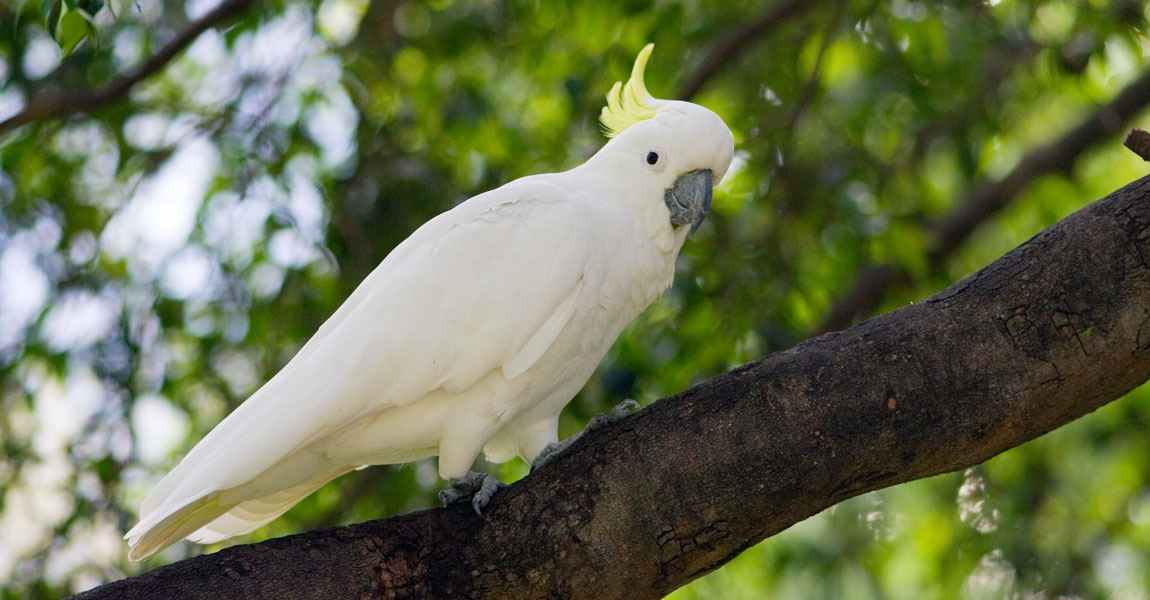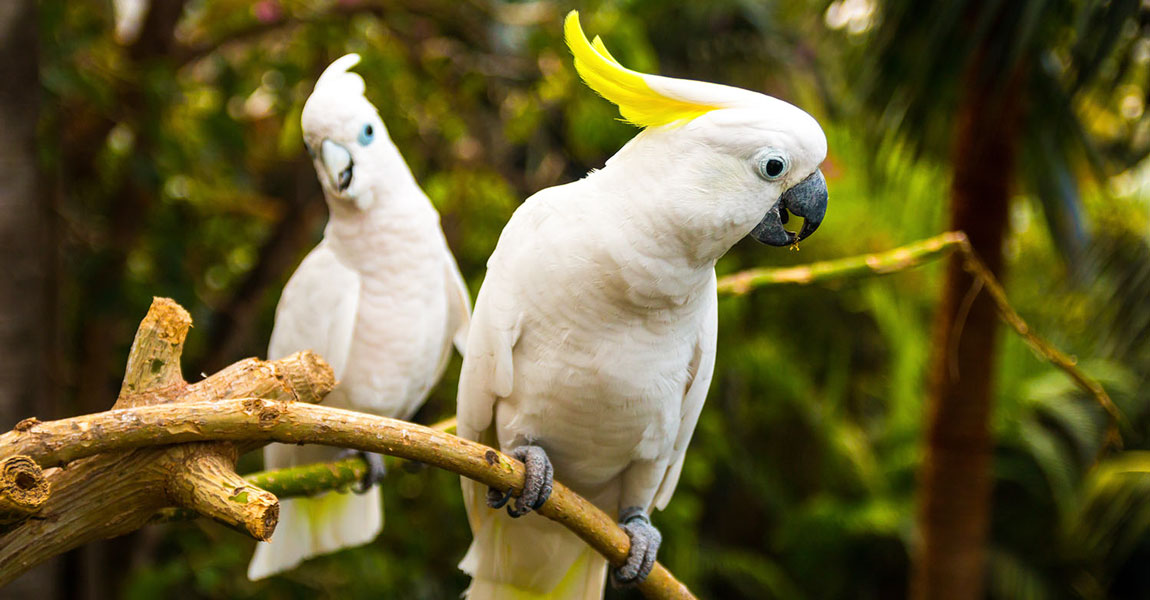Cockatoos are very smart and they learn very quickly, so you have to be smarter than they are. I know this is very hard to do, but do not go running to the cage every time your bird makes a noise. It only takes one or two times for your bird to learn that screaming equals attention. This can lead to a lot of screaming in your household.
Try not to hold or cuddle your cockatoo too much, as you do not want a “Velcro Bird”. This can lead to serious behavior problems such as screaming, and or plucking from your bird wanting to be held constantly when you are around. Try to encourage independent play. Make sure that your bird has plenty of safe toys to play with both inside and outside of his cage. Remember, your bird is a very social creature by nature so it is going to want to be a part of the family.
If you follow the few simple rules below you should end up with a well adjusted feathered member of your family.
Wild caught birds seldom turn into a screaming, plucking monster. Therefore, we must try to raise our birds like their natural parents would. A cockatoo especially must learn that it is a bird, or you end up with a confused cockatoo that does not know its place in life. Confusion can lead to a lot of unwanted behaviors and frustration to the point where the bird takes his frustration out on himself, manifesting in screaming, plucking, and/or self mutilation. We have put together some tips that should help you prevent these pitfalls.
Cockatoo raising guidelines
1.) Where ever possible babies should be raised by their parents for the first 2 to 3 weeks. When the parents feed the babies they learn that they are a bird. Sometimes circumstances do not allow this to happen and the babies are incubator hatched, so we just have to try harder to insure that the babies know that they are birds.2.) When the babies are pulled from the nest (or come out of the incubator), they should be raised in tubs with other babies (or clutch mates). This way they are already being socialized with other birds, and at the same time learning that they are birds. (Note: When it is not possible to raise babies with other babies a small stuffed toy should be placed in the tub with the baby.)
3.) Babies under 8 weeks of age should not be handled much while they are still being hand fed. If you must handle the baby, wait until at least one hour after it has eaten before you handle it. Handling the baby too soon after it has eaten can lead to the baby throwing up, and also lead to nutritional problems. It could also lead to a crop infection.
4.) Different birds ween at different ages, and your breeder or avian store will know when it is time for the baby to ween and will ween it for you before it is time for you to bring the new baby home. (Warning: Do not bring home an unweened baby unless you know what you are doing and are prepared to feed the baby yourself.)
5.) On the subject of hand feeding, there is a lot of controversy on who should hand feed and who should not. There are experts that say that you should never bring home an unweened bird. The reason for this is that hand feeding can be a very dangerous process, and is often best left to the professionals. If you do not know what you are doing when it comes to hand feeding you could possibly kill the bird or severely damage it for life. (Note: It is possible for you to learn to hand feed successfully if you have some one give you proper instruction on how to feed then allow you to demonstrate to them 3 times that you can do so successfully.)
6.) Force weening vs allowing the bird to choose to ween. It is my opinion that no bird should be forced weened, but should be allowed to choose their own time to ween themselves. To accomplish this you will have to learn to handfeed yourself, as no breeder or store will do this for you as it may take as long as a year for the bird to decide that it wants to ween. No new baby should come home before it has been on one hand feeding a day for at least a week and should already be eating some food on its own. (Be sure to tell your breeder or avian store that you do not want them to completely ween the baby as you want to do this yourself.) This will make it easier for you to allow the bird to ween itself without much danger of the bird suffering malnutrition. (Note: In the wild parents will often feed their babies up to two years of age depending on the species of bird)
7.) By the time your new baby comes home, he should be eating solid food on his own supplemented with your one hand feeding a day. He should also be able to perch and move around his cage freely without any difficulty. If your baby is use to to being with other birds you may want to place a birdie buddy or a small stuffed toy in his cage with him so he will not feel so lonely.
8.) When your new baby first comes home it is going to sleep a lot. Just like any baby it is going to need a lot of sleep. As a rule I would not worry too much about it as long as you are giving enough quiet time for the bird to sleep. Just go about your regular household duties and the bird will catch a few winks here and there during the day. If you are going to enter the room were the bird is call to him before you enter the room so that he knows you are coming and is not startled. Different birds require different amounts of sleep so as a rule around 9pm at night you should cover the cage and make things a quiet as you can.
9.) You should get as big of a cage as you can afford for the size of your bird. It should definitely not be too small, as bigger is better. At the very least he should be able to stretch his wings and flap them without hitting the sides, and should have plenty of room to move around and play with his toys.
10.) You should offer plenty of toys to encourage him to learn independent play. He needs to learn how to entertain himself while you are away, by playing with his toys. Be sure not to place too many toys in the cage so that it is not too cluttered, and rotate them at least once a week so he does not become bored. (Note: Boredom can also lead to unwanted behaviors. So you may want to move the cage to a new location once a month if you can.)
11.) If you have birds already, you may want to place the new baby next to an older bird of similar type or size so that the older bird will teach the baby how to be a bird. It is also useful in teaching the baby how to play with toys as he will see the older bird playing and will imitate the older bird.
12.) One thing you must never do is to go running to the cage every time your bird makes a sound. It only takes one or two times for the bird to learn that noise making equals attention. Once this behavior is started it is almost never stopped. Try calling to the bird from the room you are in so that he is reassured that you are still nearby.
13.) Try not to cuddle your bird too much or he may learn to demand it by screaming every time you are near and he wants attention. Have a safe place for him to play, but still be near the family, like a T-stand or a play gym. Your bird is a very social animal and will naturally want to be near you, so if you have a safe place for him to play and still be near the family he will be content without demanding attention.
14.) As your bird grows he will eventually become able to fly. This is called fledging, and it is my firm belief that all birds should be allowed to fledge. This helps them to grow up to be well adjusted birds. Before their first wing trim they should be allowed to fledge for at least a month, but only when you are there to supervise. (Note: During this time you should bird proof your house as best as you can, like no ceiling fans on while the bird is out. You want to do everything you can to see to it that he does not hurt himself.)
15.) You should also train your bird to remain where you put him. This is going to be extremely hard to do when he is fledging but this is the time the training should begin. If the bird flies off of the T-stand or play gym then pick him up and place him back on it. If he gets off again then pick him up and place him in his cage for 10 minutes. If you are consistent in this, the bird will learn that if he wants to be out among the family he will have to stay where you put him.
16.) Always remember that your bird is going to test its boundaries and your limits, and it is up to you to decide what they will be. If an unwanted behavior arises act quickly to correct it so that the bird knows it will not be tolerated. You will have to be on your toes as these birds are always finding new ways to get into trouble and to test your limits, so you have to be vigil and consistent.





